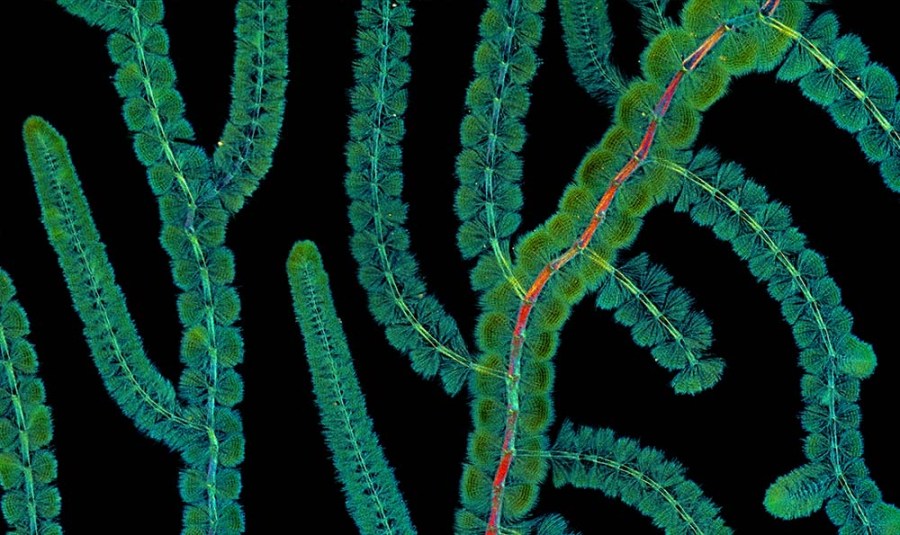Among the 9,000 entries submitted to this year’s CUPOTY 04, I’ve seen salamanders being eaten by plants, slime moulds celebrated as works of art and spiders mimicking bird poo. I’ve been awestruck by a jellyfish that walks on its hands, a marble that resembles a cosmic wormhole and an egg that seems to contain the crucible of life within its watery walls. Often I have sat there in astonishment, marvelling at the magic of it all.
Many of these moments would have gone unnoticed if they had not been witnessed by people who have a natural sense of curiosity about the world. It’s a fabulous gift, and one that I’m so grateful to benefit from. I hope you feel the same.
This year there were 11 categories: Animals, Insects, Butterflies & Dragonflies, Invertebrate Portrait, Underwater, Plants, Fungi, Intimate Landscape, Manmade and Micro, as well as Young CUPOTY. Samantha Stephens took the overall title with her incredible picture of northern pitcher plants digesting juvenile spotted salamanders, while Nathan Benstead was named Young Close-up Photographer of the Year 04 for his magical picture of slime mould fruiting bodies.
To see the winners and Top 100 pictures from CUPOTY 04, visit the website at www.cupoty.com. To stay up to date with all things CUPOTY (and receive fresh creative content) sign up to my fortnightly newsletter via the CUPOTY website.
Close-up Photographer of the Year 04 winners share the stories and techniques behind their pictures with co-founder Tracy Calder.
Overall and ‘Animals’ Category Winner CUPOTY 04
Nature’s Pitfall by Samantha Stephens
Nationality: Canadian
Occupation: Photographer

Nature’s Pitfall. Photo credit: Samantha Stephenson/CUPOTY. Taken with a Canon EOS 5D Mark III, Laowa 15mm f/4 macro lens,1/100sec, ISO 1250. Accessories: Headlamp. Post processing: Basic adjustments in Lightroom.
Northern pitcher plants (Sarracenia purpurea) are carnivorous, allowing them to survive in nutrient-poor bog environments. Here there is no rich soil, but rather a floating mat of sphagnum moss. Instead of drawing nutrients up through their roots, this plant relies on trapping prey in its specialised bell-shaped leaves, called pitchers.
Typically, these plants feast on invertebrates – such as moths and flies – but recently, researchers at the Algonquin Wildlife Research Station discovered a surprising new item on the plant’s menu: juvenile spotted salamanders (Ambystoma maculatum). This population of northern pitcher plants in Algonquin Provincial Park is the first to be found regularly consuming a vertebrate prey. For a plant that’s used to capturing tiny invertebrates, a juvenile spotted salamander is a hefty feast!
On the day I made this image, I was following researchers on their daily surveys of the plants. Pitchers typically contain just one salamander prey at a time, although occasionally they catch multiple salamanders simultaneously. When I saw a pitcher that had two salamanders, both at the same stage of decay floating at the surface of the pitcher’s fluid, I knew it was a special and fleeting moment. The next day, both salamanders had sunk to the bottom of the pitcher.
Samantha’s top tips:
- Be creative with the tools you have – this image was lit with headlamps!
- Try photographing your subject from every angle.
- Macro photography can be tricky, and photogenic moments are often fleeting. The more you practise your technique, the better prepared you’ll be to capture an image in the field.
‘Fungi’ Category Winner CUPOTY 04
Ice Encrusted Comatricha by Barry Webb
Nationality: British
Occupation: Gardener/photographer

Ice Encrusted Comatricha. Photo credit: Barry Webb/CUPOTY. Taken with an Olympus OM-D E-M1 Mark II, Olympus M.Zuiko Digital ED 60mm f/2.8 Macro, 1/15sec at f/4, ISO 200. Accessories: Tripod, cable release, three extension tubes. Post processing: Lightroom, Zerene Stacker and Topaz Denoise AI. Minor stacking artefacts were tidied up in Photoshop.
In January last year, following two days of freezing fog and sub-zero temperatures, I found some mature Comatricha growing on an old fence post lying on a pile of discarded, rotting timber. I was attracted to the way the ice had encased the slime mould, creating strange, windswept, leaf-like shapes. The tallest one was only 3mm high, including the ice. The final image is the result of 55 focus-bracketed images combined in Zerene Stacker.
Barry’s top tips:
- Don’t let cold weather put you off, it often produces unique images.
- Slime moulds are not just found in the woods; they can also be spotted on decomposing vegetation or wood.
- Creating a log pile can produce all kinds of subjects for macro photography.
‘Invertebrate Portrait’ Category Winner CUPOTY 04
Mayan Derriere by Jamie Hall
Nationality: British
Occupation: Photographer
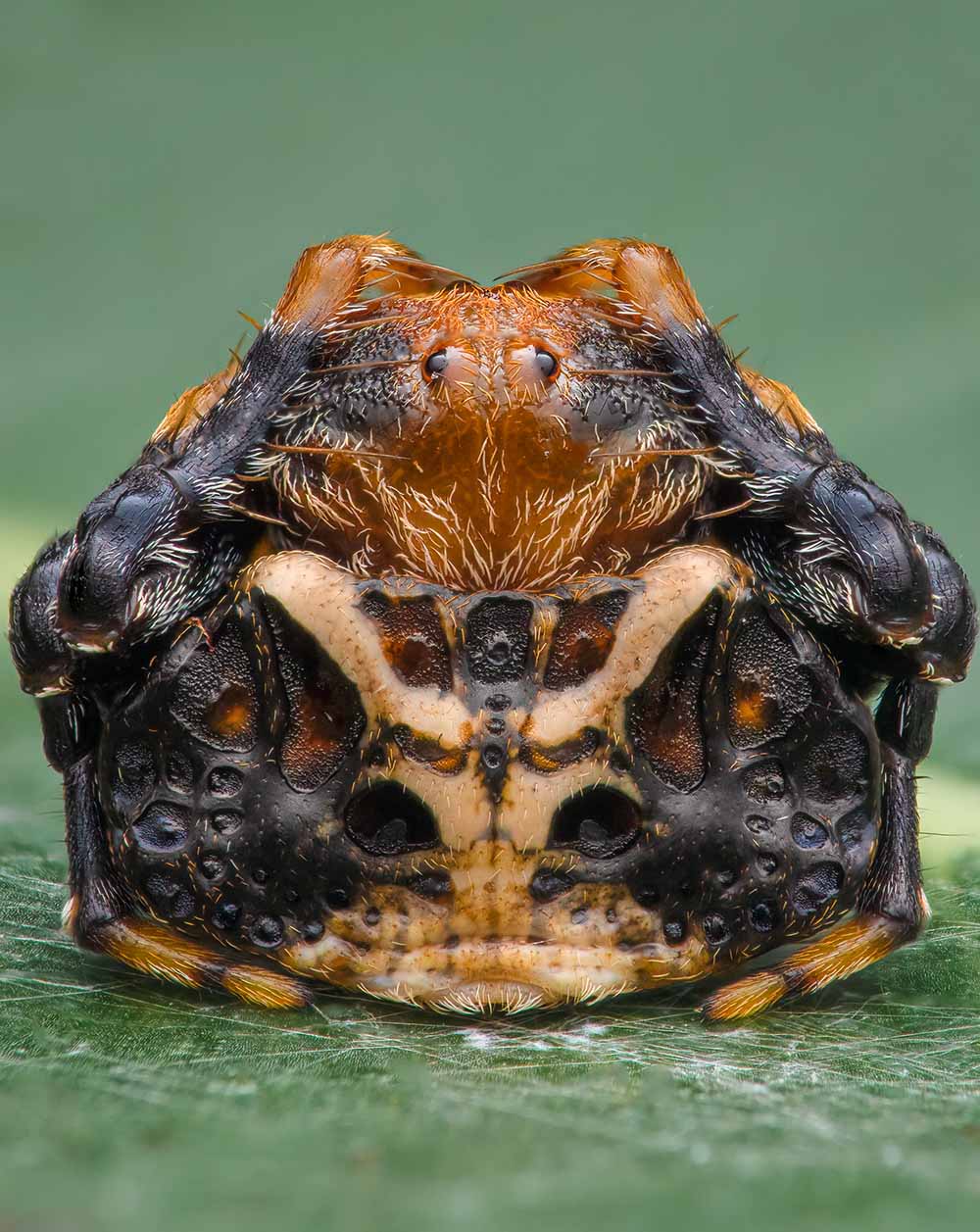
Mayan Derriere. Photo credit: Jamie Hall/CUPOTY. Taken with a Canon EOS 5D Mark IV, Sigma 105mm f/2.8 lens, 1/100sec at f/10, ISO 320. Accessories: Raynox DCR-250, flashgun with diffuser. Post processing: Final image comprises 17 frames stacked in Helicon Focus.
This triangular spider species (Arkys curtulus) is an ambush predator, not a web-based hunter like most. To hunt its prey, it sits compact and
curled up on a leaf, mimicking bird poo or other bio-debris. Balanced abdomen-side down, eyes up, it looks to the sky and watches for an unsuspecting fly or other insect to wander onto the leaf.
The abdomen on this species has some very pronounced and interesting markings, which reminded me of the Mayan carvings on rocks and stone. This individual was photographed in a conservation park in Brisbane, Australia.
Jamie’s top tips:
- Get down to your subject’s level for an image with impact, rather than shooting from your eye-level.
- Try to show your subject demonstrating natural and intriguing behaviour.
- The side of your subject with the shortest depth will require the fewest number of images in a stack for the most amount of detail.
‘Butterflies & Dragonflies’ Category Winner CUPOTY 04
Veiled by Wim Voojs
Nationality: Dutch
Occupation: Process Consultant
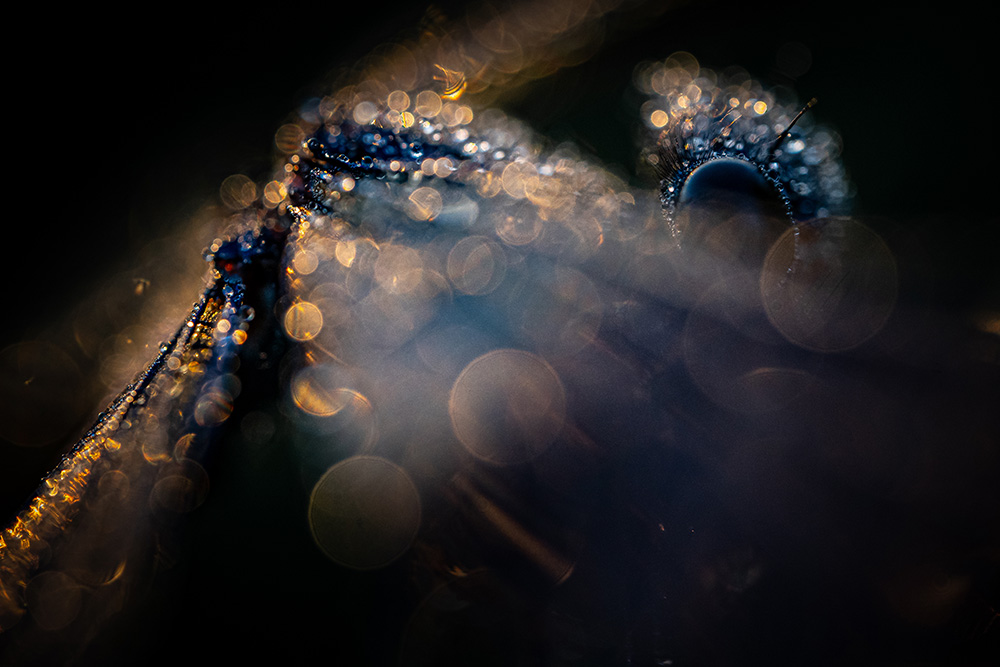
Veiled. Photo credit: Wim Voojs/CUPOTY. Taken with a Sony A7III, Laowa 100mm f/2.8 2x Ultra-Macro, 1/500sec at f/2.8, ISO 500. Post processing: Basic adjustments in Lightroom, small crop.
I found this dew-covered male banded demoiselle on a reed stem among the streams near my hometown, Ede in the Netherlands. Banded demoiselles are easy to approach as they rest and dry in the early morning. I tried to find an angle that would produce bokeh bubbles in the warm light, creating the atmosphere that I desired in the picture.
I like to emphasise the beauty of these insects by showing their strength and vulnerability. I’m not after a record shot, more an emotional portrait – maybe this is due to my background as a portrait photographer.
Wim’s top tips:
- Shoot with the lens wide open for shallow depth of field and beautiful bokeh.
- Focus manually, then you can position the focus exactly where you want it.
- Set the camera to continuous shooting and shoot while moving the camera in small increments through the DoF.
‘Manmade’ Category Winner CUPOTY 04
Oil & Water 44 by Matt Vacca
Nationality: American
Occupation: Photographer

Oil & Water 44. Photo credit: Matt Vacca/CUPOTY. Taken with a Nikon D850, Nikon AF-S Micro-Nikkor 60mm f/2.8 lens, 1/160sec at f/5, ISO 200. Accessories: Tripod, camera release, LED light. Post processing: Camera Raw for cropping, colour and tonal adjustments. Photoshop for cleaning up and spot removal.
This picture was captured as two drops of oil were merging. I’m intrigued by polarity and experimenting with oil and water has become a rich source of abstract expression. The symbiotic relationship that evolves from naturally opposing elements has become metaphoric for me. I am constantly learning and finding new inspiration, as I watch and continue to be fascinated by the dance that plays out through a macro lens.
Matt’s top tips:
- Improvise.
- Experiment.
- Be patient
‘Plants’ Category Winner CUPOTY 04
Next to my Tree by Sébastien Blomme
Nationality: French
Occupation: Engineer

Next to my tree. Photo credit: Sébastien Blomme/CUPOTY. Taken on a Pentax K-1, Pentax DA 300mm, 1/250sec at f/4, ISO 800. Post processing: Basic adjustments in Lightroom.
Snake’s-head fritillary is one of my favourite flowers. This one was taken in the city of Toulouse, France. It usually grows on wet meadows but can also be found in forests. In this image, I wanted to introduce some context, but keep the flower as the centre of interest. I managed to get a tree in the background and decided to keep it out of focus so that its shape is only suggested.
Sébastien’s top tips:
- There may be lots of subjects, but spend time finding the best specimen in the most attractive environment.
- Shoot from a low angle to get the best background possible, but also to be at the same height as the flower.
- Look for a subject in the shadows if you want a nice subtle light.
‘Insects’ Category Winner CUPOTY 04
Intruder by Anirban Dutta
Nationality: Indian
Occupation: Government Service High School Teacher
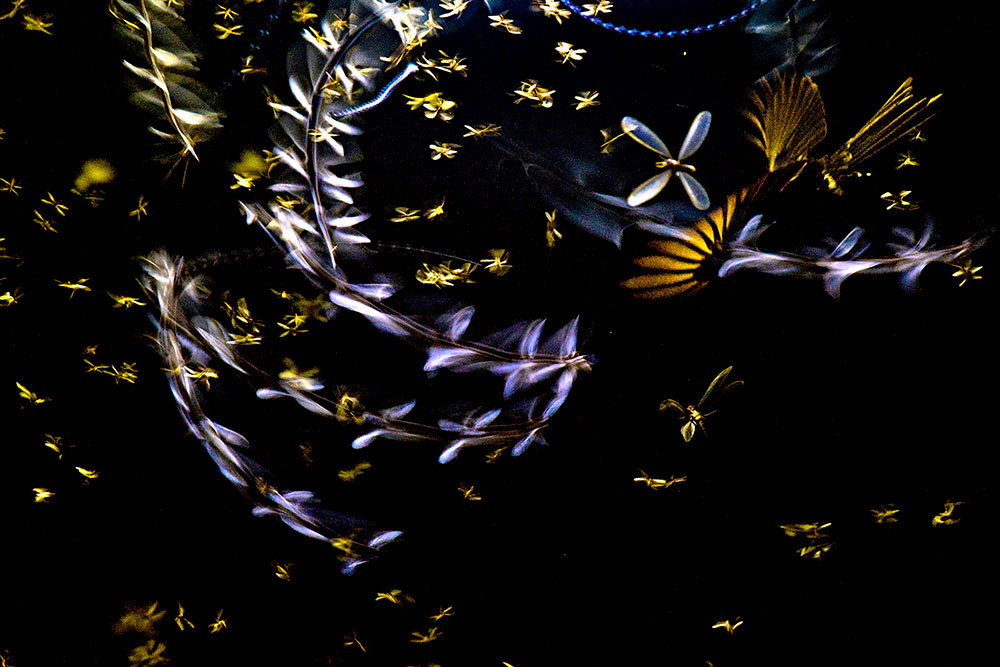
Intruder. Photo credit: Anirban Dutta/CUPOTY. Taken with a Nikon D500, Nikkor 200-500mm f/5.6 lens, 1/5sec at f/32, ISO 800. Accessories: Tripod. Post processing: Basic adjustments in Photoshop.
Before the start of the monsoon every year, some species of termite swarm in the late afternoon and early evening – this behaviour is known as nuptial flight. One day, I witnessed this event near a petrol pump in the town of Cooch Behar, India.
There were thousands of termites drawn to the powerful street light, and one black drongo. This bird spent almost 20 minutes swooping through the termites, snatching and eating them as it went. ‘I shot multiple exposures to capture this event, which I had never seen before. Three frames were recorded and combined in-camera. The first one with a high shutter speed and in Kelvin white balance, the second with a high shutter speed isolating the drongo and the third with a slow shutter speed in Tungsten white balance.
Anirban’s top tips:
- Pre-visualise the image you want to create in your mind’s eye and make sure you know the settings on your camera well enough to create it when it comes to taking the actual picture.
- Practise shooting and combining multiple exposures – it’s a challenging technique, but the results are well worth it.
- Try to use natural/available light wherever possible.
‘Intimate Landscape’ Category Winner CUPOTY 04
Frequency by Mike Curry
Nationality: British
Occupation: Photographer

Frequency. Photo credit: Mike Curry/CUPOTY. Taken with a Sony DSC-RX100 VI, 24-200mm (fixed), 1/250sec at f/4.5, ISO 125. Accessories: None (handheld). Post processing: Basic adjustments in Capture One and dust removal in Photoshop.
This is a reflection of a building at Canary Wharf in London taken in November. The water was moving in a very fluid way and I was there to try out my new Sony DSC-RX100M6 – I was particularly keen to test the camera’s fast burst and slow motion video modes. I was struggling to get it to focus on the water’s surface, but after about two hours of failed attempts it suddenly worked, and the results were amazing!
Mike’s top tips:
- Be patient: wait for calm, sunny weather.
- Be patient: you can spend hours looking for a good reflection.
- Be patient: sometimes you need to search through thousands of images that are out of focus to find a good one!
‘Micro’ Category Winner CUPOTY 04
Batrachospermum Algae by Marek Miś
Nationality: Polish
Occupation: Biologist/Photographer
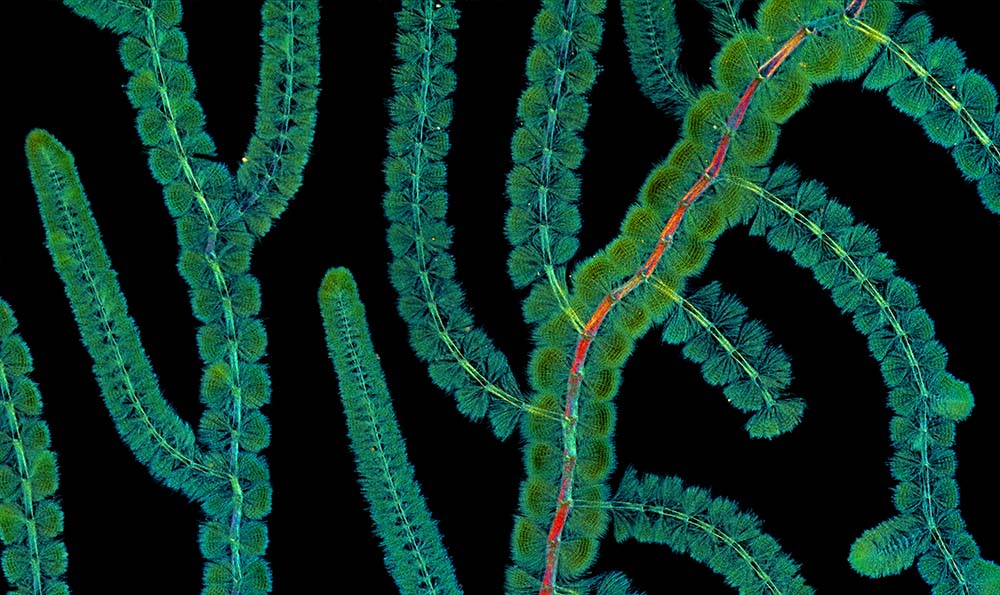
Batrachospermum algae. Photo credit: Marek Miś/CUPOTY. Taken with a Pentax K-1, Olympus 4x S-plan Apo objective, 1/5sec, ISO 100. Accessories: Olympus BH-2 microscope. Post processing: Basic adjustments and panorama stitching in Photoshop. Helicon Focus to extend the depth of field.
I took a sample of Batrachospermum (a kind of red algae) from a small river in Wigry National Park, Poland. Although it has natural beauty, it doesn’t look great using bright-field illumination. However, by combining polarised light and darkfield techniques I managed to get a colourful and interesting picture.
‘It was challenging to show more than one or two “twigs” of algae, because even a 4x microscope objective shows too small a part. To capture it properly, I made a panorama consisting of nine images stitched together during post-processing. To expand the depth of field, which is very shallow using a microscope, each of the nine images consist of several frames combined in one output image in Helicon Focus. The final image is the result of combining more than 100 separate shots.
Marek’s top tips:
- Try using different illumination techniques to bring out the beauty of the subject.
- Spend time looking for interesting subjects, and play around with colours and composition.
- To show small subjects at a larger scale, consider stitching lots of small frames into one large panorama.
‘Underwater’ Category Winner CUPOTY 04
Little Predator by Viktor Lyagushkin
Nationality: Georgian
Occupation: Photographer
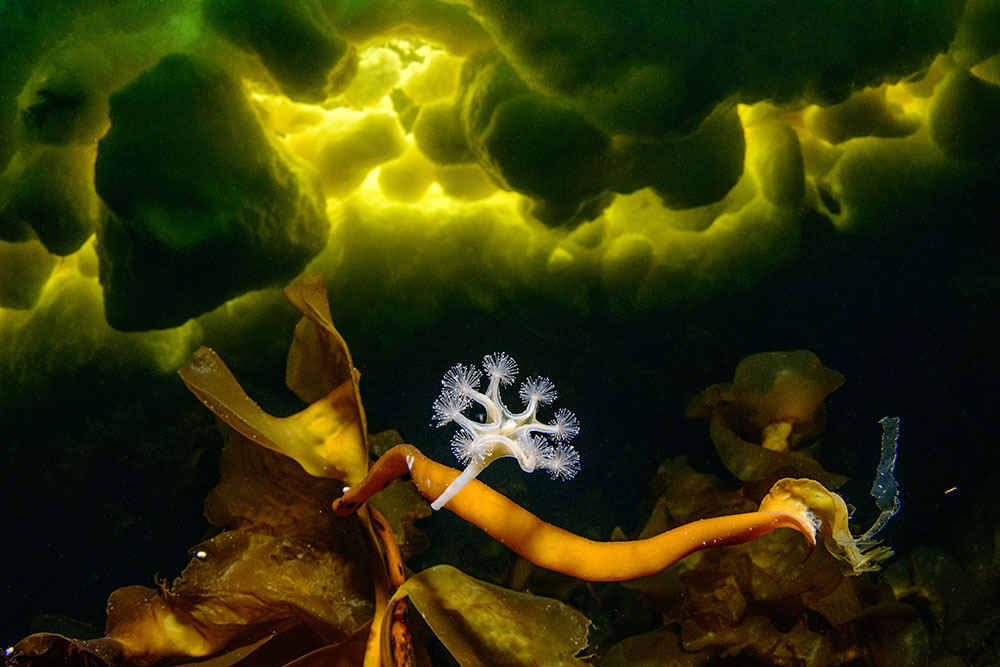
Little Predator. Photo credit: Viktor Lyagushkin/CUPOTY. Taken with a Nikon D850, Nikkor 8-15mm f/3.5-4.5 Fisheye, 1/80sec at f/13, ISO 3200. Accessories: Subal underwater housing, Ikelite DS160 flash. Post processing: Basic adjustments in Photoshop.
This is a Lucernaria quadricornis (Stauromedusae), a stalked jellyfish, photographed beneath the ice of the White Sea in Russia – the only freezing sea in Europe. The green colour of the water is a sign of spring as algae grows. ‘The “leg” of the jellyfish helps it to attach to a stone or seaweed. Its tentacles project up or down, waiting for prey. If its hunt is successful, it catches the prey and collapses its tentacles into a fist. If the hunting site is no good, Lucernaria walks away on its “leg” or sometimes its “hands”.
Viktor’s top tips:
- To take good underwater pictures, especially macro shots, an underwater photographer needs excellent diving skills to control his/her body position in the water precisely.
- Observation is useful not only for macro, but for any wildlife photographer. It is often photographers who make biological discoveries: they find new species or notice unusual behaviour in animals.
- Time spent studying the underwater world will translate into better and more varied results.
Young Close-Up Photographer of the Year
Hemitrichia calyculata, Nathan Benstead
Nationality: British
Age: 17
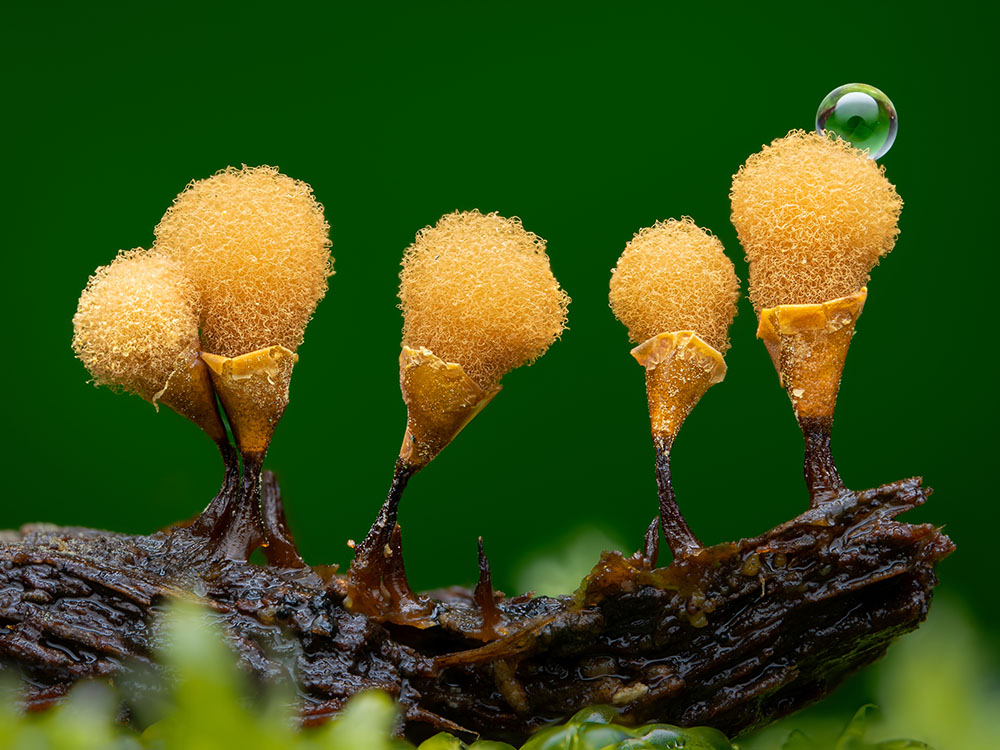
Hemitriachia calyculata. Photo credit: Nathan Benstead/CUPOTY. Taken with a Sony A7R IV, Laowa 100mm f/2.8, 1/200sec at f/8, ISO 200. Accessories: YongNuo YN-560 III flash with diffuser, tripod with NiSi NM-180 focusing rail Post processing: Stacked in Helicon Focus. Basic adjustments in Lightroom, cropped. Sharpened with Topaz Gigapixel AI
Last winter, I was walking through my local woodland, inspecting rotten logs and sticks, when I came across a log covered in slime mould fruiting bodies or sporangia. I set up my camera gear and focused on a small cluster among the moss.
Nathan’s top tips:
- Look for slime moulds and fungi a day or two after rainfall.
- Use a good-quality focusing rail mounted to a tripod for stability and to make focus stacking easier and more enjoyable.
- If you find a group of slime mould sporangia, or fungi, try to focus on any that are on their own or in a smaller separate group. It will make your images tidier.
‘Insects’ Category Finalist
Levitation by Ferenc Kocsis
Nationality: Hungarian
Occupation: Economist

Levitation. Photo credit: Ferenc Kocsis/CUPOTY. Taken with a Nikon D500, Sigma APO 50-500mm f/4.5-6.3 DG OS HSM, 1/1250sec at f/6.3, ISO 3200. Post processing: Basic adjustments in Lightroom and Photoshop.
The fragile dance of a Tisza mayfly (Palingenia longicauda) over the river at Tiszafüred, Hungary. Mayflies begin their last flight over the river at dusk in mid-June, flying for a few hours above the water before their three-year life cycle is complete. This is the largest European mayfly, and its range today is almost exclusively the Tisza and its tributaries. It’s a protected Hungarian treasure and a bio-indicator of the water quality of the Great Plain of Hungary’s rivers.
Ferenc’s top tips:
- The most important thing is to be there, at the right time; the Tisza mayfly appears above water at a certain location only a couple of days a year.
- To capture a single mayfly from the riverbank or from a boat you need a telephoto lens.
- Mayflies are quick but autofocus works pretty well in most cases. This is handheld action photography at high speed.
‘Intimate Landscape’ Category Finalist
Revisit by Andrew Baruffi
Nationality: American
Occupation: Camping Sales Lead at REI
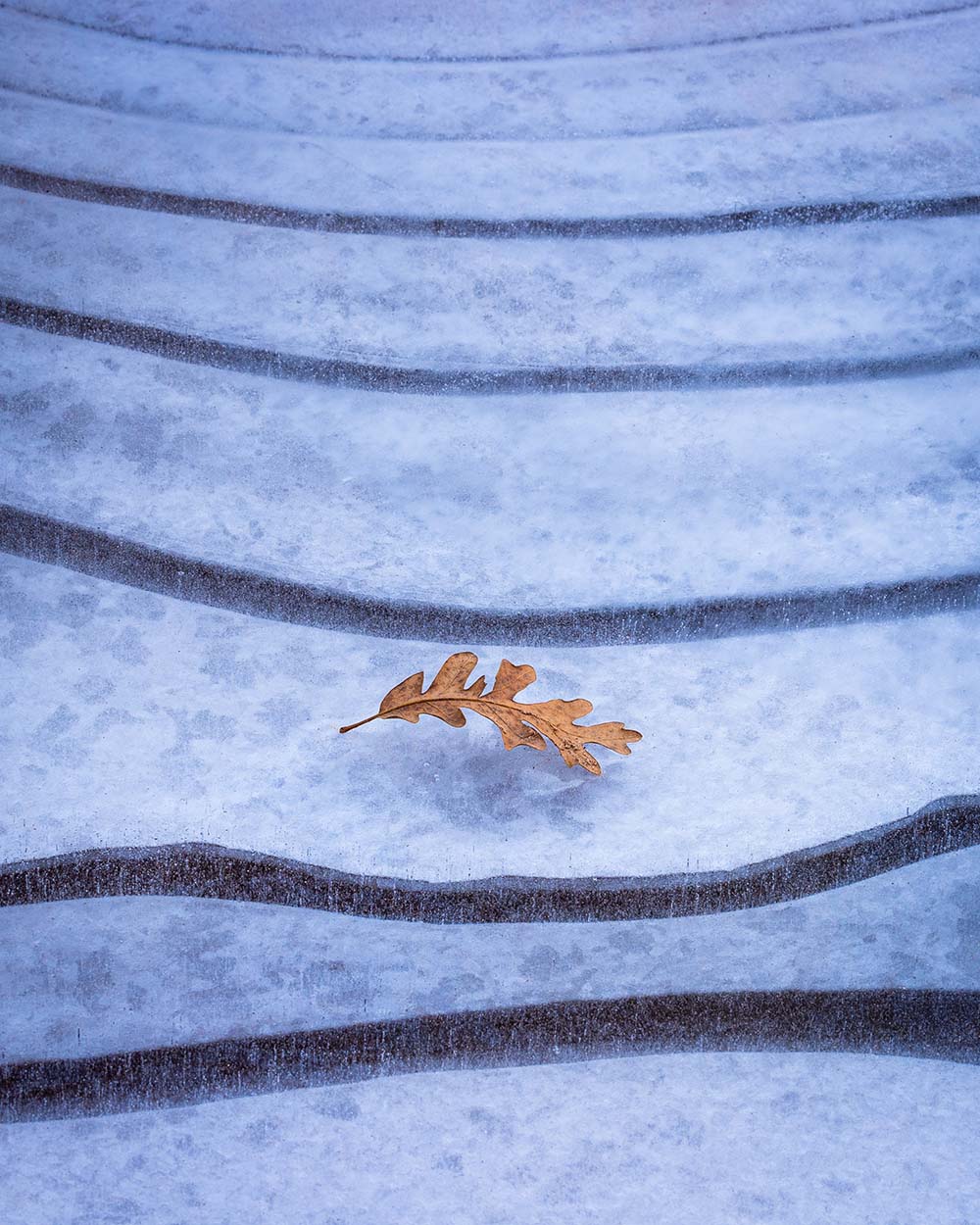
Revisit. Photo credit: Andrew Baruffi/CUPOTY. Taken with a Canon EOS 6D Mark II, Canon 100-400mm f/4.5-5.6 IS II, 1/10sec at f/16, ISO 100. Accessories: Tripod Post processing: Basic adjustments in Lightroom.
This scene was captured on a two-day shoot. The first day was spent scouting the washes of Zion’s east side for ice tucked between the boulders. In certain places deep pools of water form, freeze, and allow for detailed rings to pattern around the surface. I stumbled upon one of these pools, but the freeze was scattered and a bit too melted’.
‘I decided to come back the next morning to see what had happened overnight. I returned to a gorgeous singular freeze at the pool. The light crept into the east side and brought with it golden reflected light from the sandstone slabs opposite the scene. The reflected light kissed the surface of a single oak leaf fused into the ice and made for a nice contrast of cool and warm tones. The tip and stem of the leaf were frozen into the ice, causing the leaf to bend upward in the centre.
Andrew’s top tips:
- Go to Zion in winter and look closely at the ground beneath your feet.
- Take your time and fully explore a scene. I wouldn’t have found this image without taking the time to move around the area.
- Embrace and understand reflected light. It’s difficult to work with at first, but with patience you will get the hang of it.
‘Manmade’ Category Finalist
Wormhole by Danny Wilson
Nationality: American
Occupation: Retired
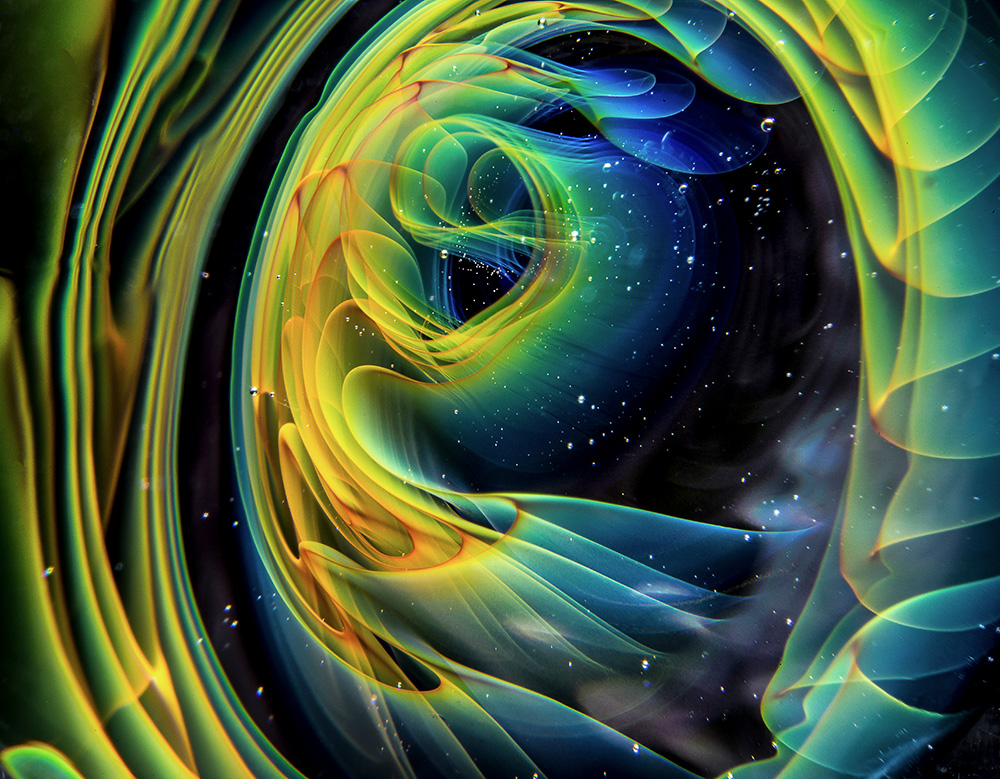
Wormhole. Photo credit: Danny Wilson/CUPOTY. Taken with a Canon EOS 6D, Canon 50mm macro, 30sec at f/32, ISO 200. Accessories: Tripod, polariser, extension tubes. Post processing: Photoshop for dust removal and Lightroom for colour and white balance tweaks.
This is a macro photo of a handmade contemporary marble (think paperweight without the flat spot on the bottom). I collect these little orbs and one day, about ten years ago, I decided I was going to try to get inside the glass with a camera. That’s what started me on this self-taught photographic journey. I’ve taken thousands of pictures of contemporary glass since then, but this is my favourite.
‘The hardest part about shooting glass is controlling the light. It wasn’t until I started holding the light source with my hand that I realised a fixed light source is much harder to work with than a mobile one. My work took off from there and I was able to capture things even the glass worker wouldn’t have spotted!
Danny’s top tips:
- For this type of picture, a fixed light source is harder to work with than a mobile one.
- Depth of field is extremely shallow at this range. You might like to experiment with focus stacking for the best results.
- Befriend your local glass artist as this hobby can get expensive quickly!
‘Underwater’ Category Finalist
From Below by Boldizsár Szűcs
Nationality: Hungarian
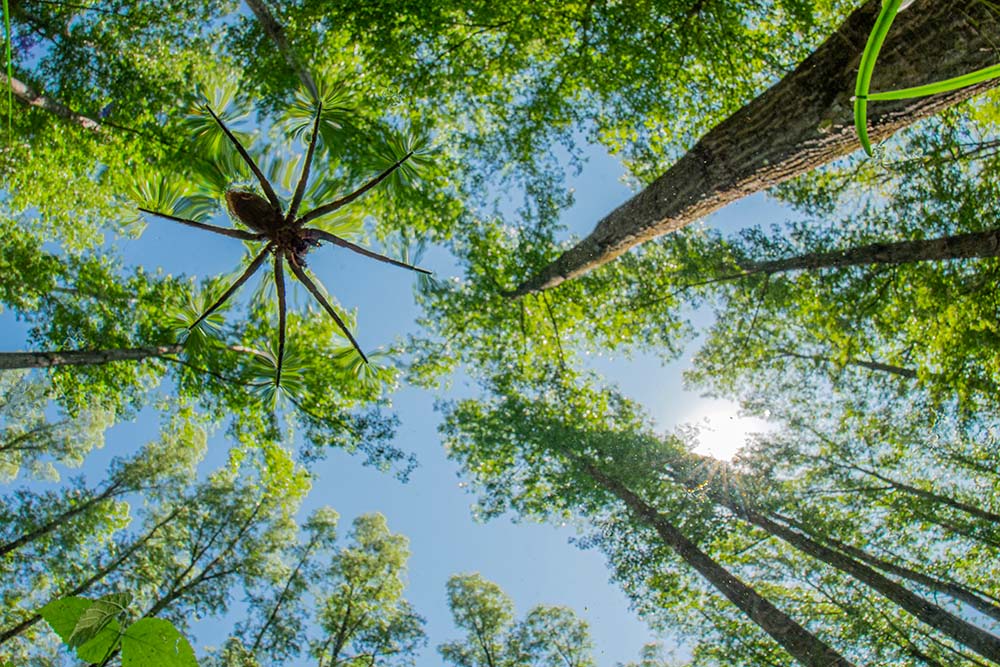
From Below. Photo credit: Boldizsár Szűcs/CUPOTY. Taken with a Panasonic Lumix G9, Samyang 12mm f/2.8, 1/80sec at f/10, ISO 320. Accessories: DIY waterproof case for the camera. Post processing: Basic adjustments in Lightroom.
I took this picture in the forest of Gemenc, Hungary. It’s the largest floodplain forest in Central Europe. It was shot in May, when the Danube river flooded, and water poured into the trees. The original plan was to photograph European fire-bellied toads, but I couldn’t find any. Fortunately, I found this beautiful raft spider (Dolomedes fimbriatus) and photographed it from below the water’s surface.
Boldizsár’s top tips:
- For this type of picture, you will need a waterproof case for your camera.
- Go to your nearest wetland and spend some time exploring and observing.
- Be very careful not to disturb wildlife.
‘Butterflies & Dragonflies’ Category Finalist
Beautiful Blue and Golden Spots by Emmanuel Graindépice
Nationality: French
Occupation: Teacher

Beautiful blue and golden spots. Photo credit: Emmanuel Graindépice/CUPOTY. Taken with a Canon EOS 6D Mark II, Irix 150mm f/2.8 Macro, 1/320sec at f/4, ISO 400. Post processing: Basic adjustments in Lightroom.
A four-spotted dragonfly on a cool morning in a wet spring meadow in Hauts-de-France. Her wings were covered with dew as she waited patiently for the sun to dry and warm her body so she could take flight. I took the picture against the light, in the middle of flowery vegetation.
Emmanuel’s top tips:
- Position yourself at the same height as your subject.
- Look for background ambience in gaps of light.
- Include vegetation in the foreground for a very soft look.
Related articles:
CUPOTY Minimal: competition open for entries
Best photography competitions to enter in 2023
Beginners guide to Macro Photography: How to create great macro photos
How to take great macro photos on a smartphone

